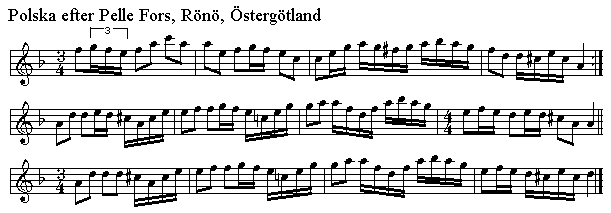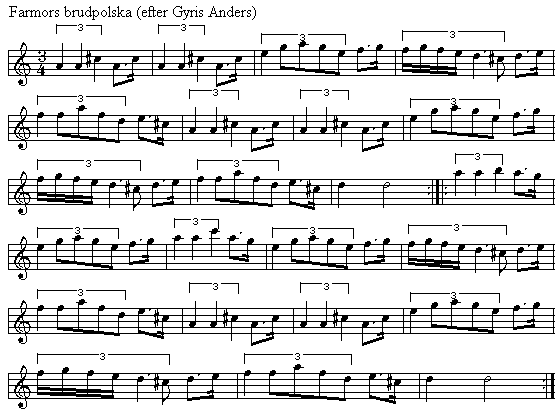Swedish Traditional Music
Introduction
| Tune Types
| Instruments
| Tunes
| Links
| På svenska (In Swedish)
Swedish traditional music (the Swedish word is folkmusik) is definitely
alive, and there are lots of people all over Sweden who play it. Someone who
plays traditional music is called a spelman, plural spelmän
(the verb att spela means "to play (music)").
A typical small festival is the spelmansstämma, plural
spelmansstämmor (which means something like "musicians meeting").
Most places in Sweden have one of these meetings once a year. Some of the
meetings are small, some (e.g. the one in Bingsjö in the beginning of
July) are very big with thousands of people arriving in for one or more
days and nights of dancing, playing, listening and having a generally good time.
During the summer these meetings are usually held outdoors. At these meetings
you often find a lot of people playing together in small groups (informal
sessions). This is called buskspel (playing in the bushes) in Swedish.
At most meetings there is also a visstuga, which is a singing session,
usually in a house so you can hear the singing properly.
There are folk music clubs all over Sweden which organize concert, dance and
session nights. Have a look at my list of links
to some clubs.
Many Swedish tunes are called something like Polska efter Erik Olsson.
This means that the tune comes from the playing of Erik Olsson (but not that
he composed it). It's similar to the way Irish tunes are often called
something like "Willie Coleman's Jig", which means that Willie Coleman
played it, but not necessarily that he composed it.
The Swedish word for tune is låt, plural låtar.
The most common type of tune in Swedish music is the polska, plural
polskor. It is a dance tune played in 3/4 time, though not the same way
as a waltz.
Other common dances are waltzes (vals, valser), polkas
(polka, polkor), schottishes (schottis,
schottisar), and mazurkas (mazurka, mazurkor).
Other common tune types are gånglåt (walking or
marching tune), brudmarsch (wedding marches), and
skänklåt ("I want to get paid"-tunes).
There are a couple different types of polska in Sweden (and in
Norway and Finland as well). Most of them are played in some kind of 3/4 time.
So what makes a polska different from a waltz? Well, first of all they are
ususally played at a slower pace (fewer beats per minute). But the main
difference is where (and how) you put the stress. A waltz has three beats
per measure. The first one is heavy and has a "downward" feeling, and the
other two are light and have an "upward" feeling, so your typical waltz goes
something like "bom - bip - bip", or you could write it graphically as:
\ ' ' \ ' ' \ ' '
In a polska, on the other hand, beats 1 and 3 are heavy and downward, and
beat 2 is light and upward, something like "bom - bip - bom":
\ ' \ \ ' \ \ ' \
The player usually taps his foot on beats 1 and 3.
In some parts of western Sweden polskas are called springlek. In Norway
they are also sometimes called springar or pols. The different
types of polska are:
- Even polska (jämn polska)
- The beats can be divided into two eighth notes of equal length. The beats
are often divided into sixteenth notes. This type is common in the southern and
eastern parts of Sweden, and in Finland.

It is a bit like a polka with three beats per bar instead if two. It
is also sometimes called slängpolska or sextondelspolska.
In some parts of eastern Sweden and Finland, people play even polskas
with all beats of equal stress. In many of these polskas it is still possible
to group the beats into multiples of three, but there are many tunes where
this is not possible. This polska, for example, has one bar with four beats.
- Uneven polska (ojämn polska)
- The beats can be divided into three triplets, or two notes of unequal
length. In some parts these polskas have so many triplets that they are called
"triplet polska" (triolpolska), but the most common version has more
two-note figures than triplets. This kind of polska is usually written with
straight eighth notes or dotted eighth + sixteenth. The rhythm has more of
a triplet feel, however.

This is a bit like an Irish slip jig or hop jig. It is sometimes called
åttondelspolska. This kind of polska is played over most of
Sweden and Norway.
- Polska with short first beat (polska med kort etta)
- This is where the rhythms start getting complicated. This is a relative of
the uneven polska, but the first beat is shortened and the second one is
prolonged. The rhythm is a bit like 2+4+3/8 time. This type is common
in the west of Sweden and in parts of Norway.

Polskas like this one would usually be written as if the beats were of equal
length. Writing it with triplets as I have written it here, is not entirely true, since there are no even three beats per bar to refer to. There are only three beats of different lengths (short, long, medium). I'll rewrite this example in 2+4+3/8 time, when I find the time.
- Polska with long first beat (polska med lång etta)
- This rhythm is even harder to understand. The first beat is prolonged,
and the third one is shortened. A bit like 4+3+2/8. Usually the player taps
his foot on all three beats. This type is also common in the west of Sweden
and in parts of Norway.
The most common instrument in Swedish music is the fiddle
(fiol). In fact it is so common that many people translate
spelman as fiddle player. Many people also play
different kinds of accordeon (dragspel). Quite
a few people play the clarinet.
An instrument which is unique to Sweden is the nyckelharpa
(key fiddle), which is like a hurdy-gurdy played with a bow instead of
a wheel. It has had a great upswing during the last few decades. The
The American
Nyckelharpa Association has a page about the
history of the nyckelharpa. There are also a number of
Swedish pages about the nyckelharpa.
Nowadays many people play the recorder (blockflöjt), but there is
also a traditional type of whistle called spelpipa or spilåpipa.
It is not too uncommon to hear
someone playing the flute either. Originally, people used to play
simple system flutes,
but for some reason this tradition died out at the beginning of
the century. Nowadays most flute players use Boehm system flutes. A very
special kind of flute is the sälgflöjt (overblown flute).
The Swedish bagpipe
is a single-reed bagpipe.
The bowing is very important in Swedish fiddle-playing. This is what makes
the rhythm come out right. I don't play the fiddle myself, so I can't really
explain how it's done.
It's quite common to retune the strings of the fiddle (scordatura). The
standard tuning G-D-A-E is very common, and the most common retuning is
A-D-A-E, which is called A-bas. In some parts of Sweden (especially in
the west) this tuning is so common that it is called standard tuning. Another
common tuning is A-E-A-E, which is suitable for tunes in A.
A very special retuning is A-E-A-C#, which is called
näckastämning or trollstämning. These tunes
are associated with the devil (fan or hin onde) or with
fairy-tale creatures such as trolls (a bit like ogres or goblins) and
näcken, and often use special effects,
such as left-hand pizzicato.
The most common kind of accordeon is probably the five-row button accordeon
(femradigt dragspel), which has the same note on push and pull. Piano
accordeons (pianodragspel) are also common.
Accordeons (or melodeons) with different notes on push and pull are called
durspel. The most common kinds are two-row (tvåradigt) and
one-row (enradigt) accordeons.
Many fiddlers of old were said to have learnt their music from
näcken. Näcken is a water spirit, who lives in
streams, and plays the fiddle. Aspiring fiddle players can learn to
play from him so that no-one can stop dancing.
Swedish Traditional Music / © 1998 Henrik Norbeck /
henrik@norbeck.nu


